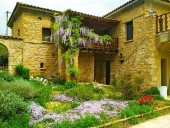






 2
2













Miles Flansburg wrote:Hay Tristan, thanks for the update! Looks like you have made a lot of progress. Good stuff!
 1
1




 1
1




 They don't spend much time outside since nobody's watching out for them, but they've been out a few times already. Adorable little guys, too
They don't spend much time outside since nobody's watching out for them, but they've been out a few times already. Adorable little guys, too 













 1
1




 Also, there's a shot of the garlic putting on scapes, peonies in bloom, comfrey (there's three clumps, two of which have been harvested for mulch) and you might be able to spot some of the roma tomatoes mixed in with mint under the garlic or along the bottom of the hill with that single line of garlic.
Also, there's a shot of the garlic putting on scapes, peonies in bloom, comfrey (there's three clumps, two of which have been harvested for mulch) and you might be able to spot some of the roma tomatoes mixed in with mint under the garlic or along the bottom of the hill with that single line of garlic.





 8
8






 6
6




 7
7




 Though some things have changed with years of observing and interacting with this property, many of the "big picture" points are still much the same. It's truly incredible how, by using permaculture's toolkit, I was able to draw up rough plans that STILL apply after almost 10 years of playing with designs, installing earthworks, etc.
Though some things have changed with years of observing and interacting with this property, many of the "big picture" points are still much the same. It's truly incredible how, by using permaculture's toolkit, I was able to draw up rough plans that STILL apply after almost 10 years of playing with designs, installing earthworks, etc.
 5
5




 5
5




![Filename: google-aireal-2018.png
Description: [Thumbnail for google-aireal-2018.png]](/t/32322/a/183438/google-aireal-2018.png)
 7
7




 7
7




 8
8




 7
7





 10
10





 4
4




How Permies works: https://permies.com/wiki/34193/permies-works-links-threads
My projects on Skye: The tree field, Growing and landracing, perennial polycultures, "Don't dream it - be it! "
 6
6




Nancy Reading wrote:I have to admit I haven't read through all your posts, just the more recent ones. You must be proud of what you have achieved.
I once hired a little sit on digger to dig some foundation trenches (I got the easy job, the guys were wheeling the spoil away by hand!) it was great fun. We now have a little 2.4 tracked digger which I've not been able toplay withuse as yet. My husband said it was the law on Skye that you had to own a digger(!)
What sort of temperature gain do you think the earthworks have given you? I'm thinking of digging a pond myself (been thinking of it for about 14 years, but it might happen sometime soon) and I may change the design to make more of the sun aspect. I'm going to be digging into rock probably, since I generally only have a foot or so of soil, but I would like to have a pond that is deep enough to have a swim. If I can get a solar gaining/ wind stopping berm at the north end, it could make the whole thing much more pleasant on a sunny day. I'll probably have to buy in bentonite clay to line it, since there is next to none locally.
Thanks for the update on the thread. I'll go back and see how you started now!

 Adding the gravel on the shelves and beach will likely increase the summer temperature gain significantly, and if that ends up being dark colored, even more so.
Adding the gravel on the shelves and beach will likely increase the summer temperature gain significantly, and if that ends up being dark colored, even more so.
 It's a big, ongoing project on multiple acres, so its exhausting at times, mentally and physically
It's a big, ongoing project on multiple acres, so its exhausting at times, mentally and physically 6
6




![Filename: pad-position.jpg
Description: [Thumbnail for pad-position.jpg]](/t/32322/a/184674/pad-position.jpg)
 5
5






credit: Digging in the Driftless
 6
6




 6
6






 6
6





 8
8




 The majority of the sun hitting the "pad" comes from the southeast during morning hours, with more shade in the afternoon due to larger evergreens along and beyond the western property boundary. With addition on a solid fence or wall, or perhaps a small structure (tool shed? firewood storage?), on the east side of the pad to create a wind block, the "courtyard effect" will still be in play to help prevent cold damage to the more tender perennials.
The majority of the sun hitting the "pad" comes from the southeast during morning hours, with more shade in the afternoon due to larger evergreens along and beyond the western property boundary. With addition on a solid fence or wall, or perhaps a small structure (tool shed? firewood storage?), on the east side of the pad to create a wind block, the "courtyard effect" will still be in play to help prevent cold damage to the more tender perennials.


 4
4




 5
5




 5
5






 1
1





 1
1




 1
1





 1
1




 1
1




 1
1




 1
1






|
Good night. Drive safely. Here's a tiny ad for the road:
The new permaculture playing cards kickstarter is now live!
https://www.kickstarter.com/projects/paulwheaton/garden-cards
|





